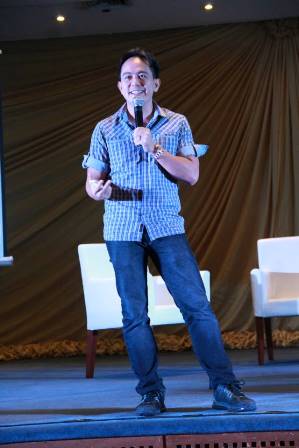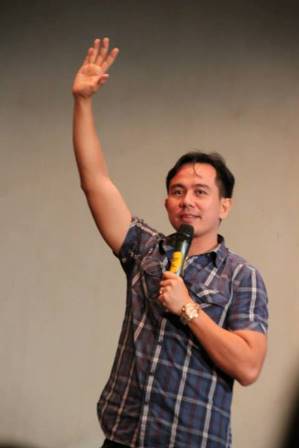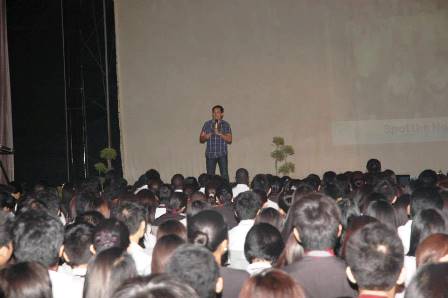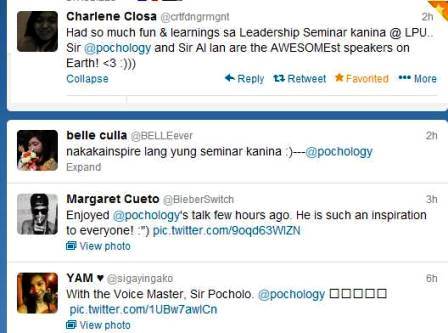Pocholo “The VoiceMaster” Gonzales inspired and motivated the Sales Manager of Green Circle realty company. The owner of Pro Friends Mr. Jerry Choa appreciated him and even found as an amazing speaker. The audience, including Mr. Choa, listened to him during his talk held at the Tektite Auditorium, Ortigas center.
0 Comments
Pocholo “The VoiceMaster” Gonzales once again rocked a school as he talked about branding passions last July 27. During the talk, he was able to inspire the students from the Lyceum of the Philippines University Batangas. No wonder, lots of students were so grateful and amazed by the motivational skills of the VoiceMaster as well as his knowledge.
Interviewer: Ilang taon ka nang Voice Master?
Pocholo: I've been in the industry for 16 years. Inteviewer: Can you give me 5 samples? Pocholo: Paborito ko yung mga Presidents dati, si FVR, ah sandali lang Stanley no ang gwapo mo pala, ako si Noynoy Aquino walang pagbabago. Interviewer: Okay ah. Pocholo: Broadcasters, sila Mike Enriquez, magandang araw mga kapuso at dahil dito hinding hindi naming kayo tatantanan. Interviewer: E si Jessica Soho kaya mo? Pocholo: Ah, mahirap yan, babae yan. Interviewer: Mga comedians po kaya nyo? Pocholo: Michael V. yung paborito ko, ito po si Michael V big big size, big big taste manood kayo. Interviewer: Kayo yata nagvoice over ng commercial nay un, hindi yata sya yun e. Interviewer: Turuan nyo ako kung papano maging isang voice artist. Pocholo: Oh sige. Interviewer: Papano ba? May project yata kayo? Yung Noli Me Tangere. Pocholo: Actually, meron tayong ginagawa at ah gusto ko gagawain na natin si Padre Damaso, kaya mo ba yun? Interviewer: Subukan na natin sa loob. Pocholo: Once you're behind the mic, don't be conscious, don't be yourself, be the character you are portraying. Pocholo Gonzales - CreatiVoice Production
host-good evening ladies ang gentleman,welcome up close and personal.ngayong gabi makakasama natin ang grupo ng CreatiVoices,alamin po natin yan mayamya lamang malalaman nyo po kung sino ang mga boses behind the movies,television or video shows na napapanood nyo po,na napakadali po nilang magpalit ng mga boses,ewan ko kung papano nila nagagawa,alamin po natin yan sa up close ang personal ngayon gabi kasama po ang presidente ng CreatiVoices wala pong iba kung hindi ang kasama ko din sa marketing association si pocholo gonzales. Over the last few days, the Internet has been abuzz regarding this article, in which the author posits a so-called “Pixar Theory,” the notion that every one of Pixar’s films are connected and take place in the same, eventually apocalyptic universe. There is, unfortunately, no way for this writer to tackle that theory in any great detail without sounding like a Debbie Downer. Jon Negroni’s argument is, in essence, a Pixar fan’s attempt to out-do the conspiracy theorists on display in Room 237, the excellent 2012 documentary about Stanley Kubrick’s The Shining. So we can, on the one hand, acknowledge the ballsiness of Mr. Negroni’s concept and the amount of thought and time he put into its existence, but it’s almost too easy to poke holes in the theory.
So instead, let’s focus today on a topic that’s come up in the Pixar Perspective in the past: voice acting. A couple of months ago, this column extolled as one of Pixar’s virtues their willingness to not always or only cast big-name celebrities for their animated movies, specific to how frequently they cast stand-up comedians like Patton Oswalt, Don Rickles, or Ellen DeGeneres in lead or major supporting roles. Though Pixar may lean more on recognizable names than on prolific voice actors like Maurice LaMarche, Billy West, Tress MacNeille, or Jess Harnell to play the leads, they often do not rely solely on celebrities to do the creative heavy lifting. (It is worth noting that Pixar does, like most animation studios, use some of those voice actors in small roles in their films, such as Mr. Harnell, who Samad Rizvi, The Pixar Times’ editor-in-chief, recently interviewed regarding his work in Monsters University.) Pixar may use famous people—or people whose faces we recognize even if they aren’t household names yet, as with Kelly MacDonald voicing the lead in last year’s Brave—in their movies, but rarely, if ever, because they expect a person’s name and voice to fully and totally define their characters. Most, though not all, of DreamWorks Animation’s output, even now, operates on this fundamentally lazy plane of creativity. Though the argument applies heavily to DWA’s new film, Turbo, which opens tomorrow and owes a steep debt to Ratatouille, more than you might think from the marketing campaign, let’s look instead at two older and conceptually similar examples. One, from Pixar, is Finding Nemo. The other, from DreamWorks, is Shark Tale. The former transcends its setting, and is wall-to-wall with artistry and vibrant storytelling. The latter, for a number of reasons, is like watching a feature-length episode of The Flintstones. A big part of that creative stumble is the voice casting. When a marketing campaign is unleashed for an animated movie, and the names of the actors playing the lead roles are trumpeted louder than even the story, it may end up being a warning that the movie is going to rely on you, the audience member, knowing those actors’ personas up and down. Take Shark Tale, which featured the voices of, among others, Will Smith, Robert de Niro, Angelina Jolie, and Martin Scorsese. Even Scorsese, someone who’s not predominantly known for his acting chops, is someone you probably can describe in a few words if you were asked to do so. Will Smith? He’s cocky and wise-cracking. De Niro? He’s a gruff, tough type who’s most comfortable playing criminals. Angelina Jolie? She’s enigmatically beautiful and alluring. And so, you have the characters they play in Shark Tale, never given any dimension beyond those basic, actor-specific traits. Shark Tale, unlike most of DreamWorks Animation’s other movies, goes as far as animating their characters to look more like the actors than like undersea creatures. Turbo does not, thankfully, show us exactly what a mollusk would look like if he was Ryan Reynolds-sized, but the voice work from actors like Samuel L. Jackson and Snoop Dogg is such that, the more you know about their previous work in film and music, the more you’re expected to get a kick out of their performances. Now, look at Finding Nemo. Like most modern animated movies, this film has a large ensemble cast well beyond the leads. Yes, we have DeGeneres and Albert Brooks in roles that, initially, play on our familiarity of their live-action personas: DeGeneres’ flighty, flaky on-screen demeanor is translated into the forgetful but charming Dory, and Brooks’ intense neuroses help fuel Marlin from the start. The difference between Finding Nemo and Shark Tale in how they employ their voice cast is that the former film doesn’t exclusively use its actors’ traits to inform their characters. Yes, Albert Brooks, in movies like Modern Romance, Lost in America, and Broadcast News, is defined by his self-loathing and neurotic attitude. And yes, Marlin is similarly stifled and frightened of the world around him, but Marlin changes throughout the film; Brooks’ excellent, emotionally pitch-perfect performance allows Marlin’s arc to be truly believable. The same goes for DeGeneres’ performance, but where Finding Nemo truly excels is in the deep, rich, creatively fertile ways in which the ensemble cast is employed. Shark Tale’s cast includes Smith, Jolie, de Niro, Scorsese, Ziggy Marley, Jack Black, Katie Couric, Renee Zellweger, Michael Imperioli, and Vincent Pastore (the latter two best known for their work on HBO’s The Sopranos). Finding Nemo’s cast includes Brooks, DeGeneres, Willem Dafoe, Geoffrey Rush, Eric Bana, Allison Janney, Vicki Lewis, Brad Garrett, Stephen Root, and Austin Pendleton. (And, bringing it up again, Turbo’s ensemble includes Reynolds, Jackson, Dogg, Paul Giamatti, Michael Pena, Luis Guzman, and Bill Hader.) Shark Tale and Turbo are films that are, arguably, filled with more celebrities, more actors defined by specific roles or traits. Actors like Garrett, Root, Lewis, and Pendleton are closer to the well-known Hey! It’s That Guy actor, people you know you’ve seen before even if you can’t remember exactly in what. As such, they can easily disappear into a role, the animators providing a role for them instead of the other way around. In essence, the value of a voice performance in an animated film is directly connected to how much that film’s creators require you to recognize its source. One of the overriding sources of humor in Shark Taleis not the characters de Niro and Scorsese are playing, so much as some of its audience members realizing that the actor and director of films like Taxi Driver and Goodfellas are playing criminal cohorts in a family movie. And what is the joke regarding the characters Imperioli and Pastore play if not that, hey, they’ve also played mobsters before? Leave aside any awareness or admittance that maybe, just maybe, the wide number of children watching Shark Tale are likely not that familiar with the Mob-themed movies and TV shows that have littered American popular culture over the last 20 years. No, all that matters is bringing together big-name celebs to give full life to these characters. The script will do no such heavy lifting. What can be most vexing about voice acting in mainstream animated movies is that the famous are used to fill the holes of a weak or familiar script. (Again, though opinions may vary once the film opens tomorrow, Turbo is arguably another victim of this unfortunate creative decision.) Monsters University, like Monsters, Inc., doesn’t fall into that trap, thankfully. Though Billy Crystal and John Goodman were well-known for their live-action work before the 2001 film, their work as Mike and Sulley is filled with hidden depths that rely on them less for their established personas and more because of their inherent, raw acting talent. The same goes for Monsters University, where even those few actors cast partly thanks to their live-action work and a familiar, singular persona—Helen Mirren as the suitably imperious Dean Hardscrabble stands out—are given more to do aside from simply reiterating what we know best about them. And while a number of the Monsters University cast members, from Charlie Day to Bobby Moynihan to John Krasinski, may be familiar to comedy fans, few were cast specifically because of a single, highly identifiable trait. They were cast, basically, because of the elasticity of their voices, because they can do more than read lines of dialogue in their normal vocal patterns. Pixar’s films are not automatically a creative improvement upon those by DreamWorks Animation because of who they cast. As mentioned here in the past, Pixar’s first film aimed extremely high with its lead; Tom Hanks is many things, but one of them is, and certainly was in 1995, immensely popular. Hanks playing a purehearted cowboy seems like a deliberate nod to how often he’s dubbed the modern version of Jimmy Stewart. (Of course, had Billy Crystal played Buzz Lightyear, a role he was offered and famously turned down, it would’ve likely required him to be as antithetical to his comfort zone as possible.) What matters is that when Pixar hires celebrities to be in their movies, they are not just handing these people a paycheck and inviting them to coast. It’s always fascinating to watch voiceover recording sessions, partly because they’re not often included as special features on Blu-ray or DVD releases. But if you watch some of the work that Hanks and Tim Allen did for Toy Story 3—recording together some of the time, which is, in itself, rare—you’ll notice that the two men were not relaxing. They were working. They were acting. Here is, boiled down simply, the difference between how DreamWorks Animation and Pixar Animation Studios deals with celebrities in their movies. When considering the term “voice actor,” the former company focuses on the voice, and the latter company focuses on the actor. Movies likeShark Tale and Turbo are peopled with actors who’ve been called on for the surface-level pleasures audiences may associate with their voices. Movies like Finding Nemo and Monsters University are peopled with actors who’ve been called on to do work as challenging as anything they may deal with in the live world. Being a voice actor, by most accounts, could easily become a job where, depending on your level of fame, you don’t have to work hard. One of Pixar’s great achievements in the last two decades is that its filmmakers do not associate voice acting with laziness. They make their actors work, instead of just reading dialogue into the void. A few tips and tricks I’ve learned along the way.
Over the course of my career, I’ve done a lot of voice over recording for Nickelodeon and PBS. Working with animated kids’ TV and games is a total blast. But recording dialogue with child actors is very different from working with adult actors. So I thought it would be helpful to share a few things I’ve learned. Recording Tips:
Technology has progressed significantly in the last few decades, and it opened up new opportunities for actors both on screen and behind it. Particularly video gaming and animation industry has greatly expanded. And it’s not just big studios cranking out their products — due to the ease of access these days, small independent video game developers and animation studios also require good voice-over acting talent for their new projects.
However, a lot of budding actors seeking work on stage and/or screen make a crucially poor judgement of how competitive the voice-over acting field is. In short, it is very competitive, mostly because people — not just actors alone — view this field as something that anybody can do. Unfortunately — no matter how Jack Black sees it — that is not the case for non-celebrity voice-over actors. A Career in Voice-Over Acting: Part 1Years ago, voice-over used to be all about the definition of your voice. Masculine and confident, feminine and delicate — that was enough. These days the situation has permanently changed, and this industry is not so much about the voice anymore; it’s about actually acting and engaging your voice-over acting skills (and you better have those skills if you want to succeed here). No newcomer can just come in with a unique voice and do it, it doesn’t work this way any longer. Everybody needs training! Aside from the fact that it isn’t as easy to start in voice-over, there are another few obstacles waiting behind the corner. Since about 5-6 years ago, a good chunk of celebrity actors have started doing voice-over on a yearly basis. They always manage to squeeze in a feature animation film or a triple-A video game somewhere between their blockbuster movies. Furthermore, since voice actors aren’t visible and their voice changes slightly with every character, it’s more difficult for the audience to get tired of them, which means one voice actor can do five times more gigs than they would be able to do for the camera. They also don’t take up as much time as filming or a play does, and if the offers are on the table, doing 5 to 10 projects of different sizes a year for a famous hardworking voice actor will not be an issue. But, after all this reality check, keep in mind that there are still opportunities for aspiring voice-over acting talent, and if you’re one of them, you just need some good advice on how to approach this competitive but very rewarding career in voice-over. Voice-Over Acting Audio DemoUnless you’re a known name within the industry or a huge celebrity, nobody is going to hire you for any voice work without hearing your voice-over demo first. Just like film/TV and stage actors have headshots and acting CV/resumes to show off, the number one thing for voice-over actors is their audio demo. Even if an aspiring voice actor doesn’t have a single voice-over acting credit, there is still a good chance they are going to be called in based on what the casting director hears in presented material. It is crucial for the demo to be professionally made; it cannot be something you have recorded with your laptop microphone and put together with Movie Maker. To have a successful career, a voice actor — like any other struggling performer — must invest first to raise the chance of being hired. Spend a good amount of time looking on the Internet for the best deal where somebody can make you a professional demo out of the recordings you already have. If you don’t have any, they will help you with that, too (for additional charge, of course). What should the demo look like? Talent agents love a short one, no more than a minute or a minute and a half tops, and made up of different quality parts to show off your range of voice-over acting. Make it up from 5-7 bits, and have them transition smoothly. This will show variety to your future agent or a casting director. Some agents/casting directors might request a longer demo on occasion, so if you’re in a position to provide that, the better you’ll come off. Stay away from any additional sounds, fade ins and outs. When recording your voice-over demo, avoid sounding similar in every bit. Also, try not to forget about the energy that you must put into there — it has to grab the attention of the person listening to your voice. Remember, it will be heard by thousands and maybe millions of people (depending on the gig), and that is a number one concern on a casting director’s mind, so it should be yours, too. Stay within your range. Just like there is “playing age” for actors on stage, screen and TV, there is also a range that voice-over actors must stay with. For example, if you’re 18 and sound young, you should not be doing a recording for Barclays about pension, and vice versa — if you’re 70, you probably should avoid recording an ad about the new video games console coming out. Unless, of course, there’s an idea behind that, possibly with a hint of comedy and aimed towards a specific project you’re submitting to. Voice-Over Acting TrainingVoice-over training is crucial. The importance of training. Some classes provide you with a voice-over demo after you finish. While it might be for an additional charge, it is still usually a better price than going privately. Plus, you’ll get a lot of tips and advice while recording your voice(s) throughout your voice-over acting class. Weight your options and check which deal comes out to work best for you; after all, the pursuit of voice-over career will cost you a little down the road, but hopefully you’ll be booking paid gigs at the same time. Remember that taking a voice-over class is vitally important. For an untrained eye (voice?) it might seem there isn’t much to learn when you have a good voice, but you’ll be surprised how much detail goes into voice-over acting. Additionally, your chances of getting called in are going to be much greater when you have a known voice-over class mentioned on your CV/resume. While learning all about the craft, you will also be coached on how to best record your future voice-over demo, which is another great selling point. The perks of pursuing voice-over acting compared to film/stage/TV acting is that you might be able to avoid spending as much cash down the road and probably have more time to devote to your future career. You also don’t have to get and send your headshots when applying for voice work; appearance is absolutely irrelevant. Some voice actors still do, they believe it will make the casting director see (hear?) them that way. However, it’s a gamble, as you never know if the casting director will like what he/she saw. Better to avoid this. Voice-over acting is an amazing job to pursue and build a career in, but you have to put in the work. While it’s possible to go after screen, stage and voice-over at the same time (if you do not require any survival job to fund years of struggle), it is not going to be an easy journey. The general advice is to pick one path, and once you have at least some minor success in that field, start looking a little to the side. In our second part on voice-over acting next Monday we’re going to talk about best locations for pursuing this career, voice-over agents, how this process works and what else it takes to become successful in this very competitive field of voice-over work Who Wants To Be A Voice Artist?
PROMINENT MAKATI STUDIO GIVE FANS A CHANCE TO LIVE A DREAM |






 RSS Feed
RSS Feed